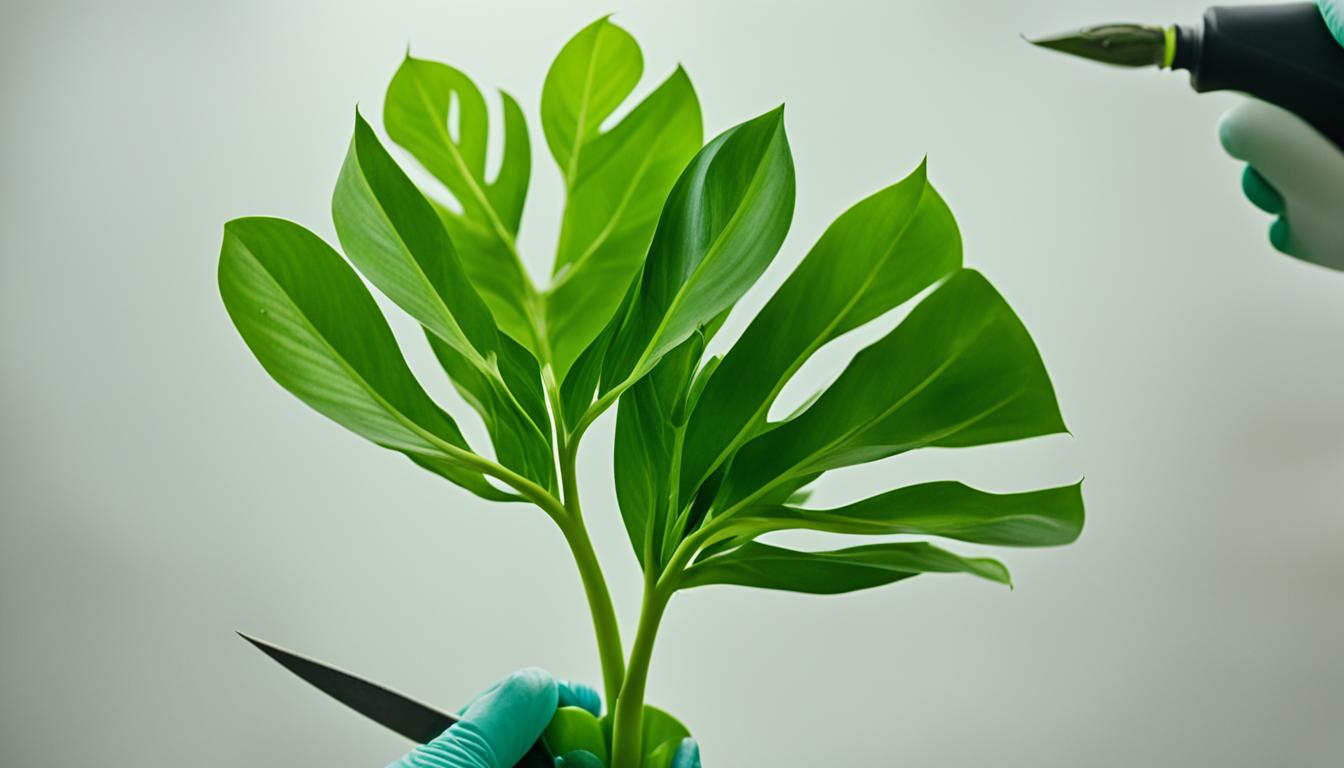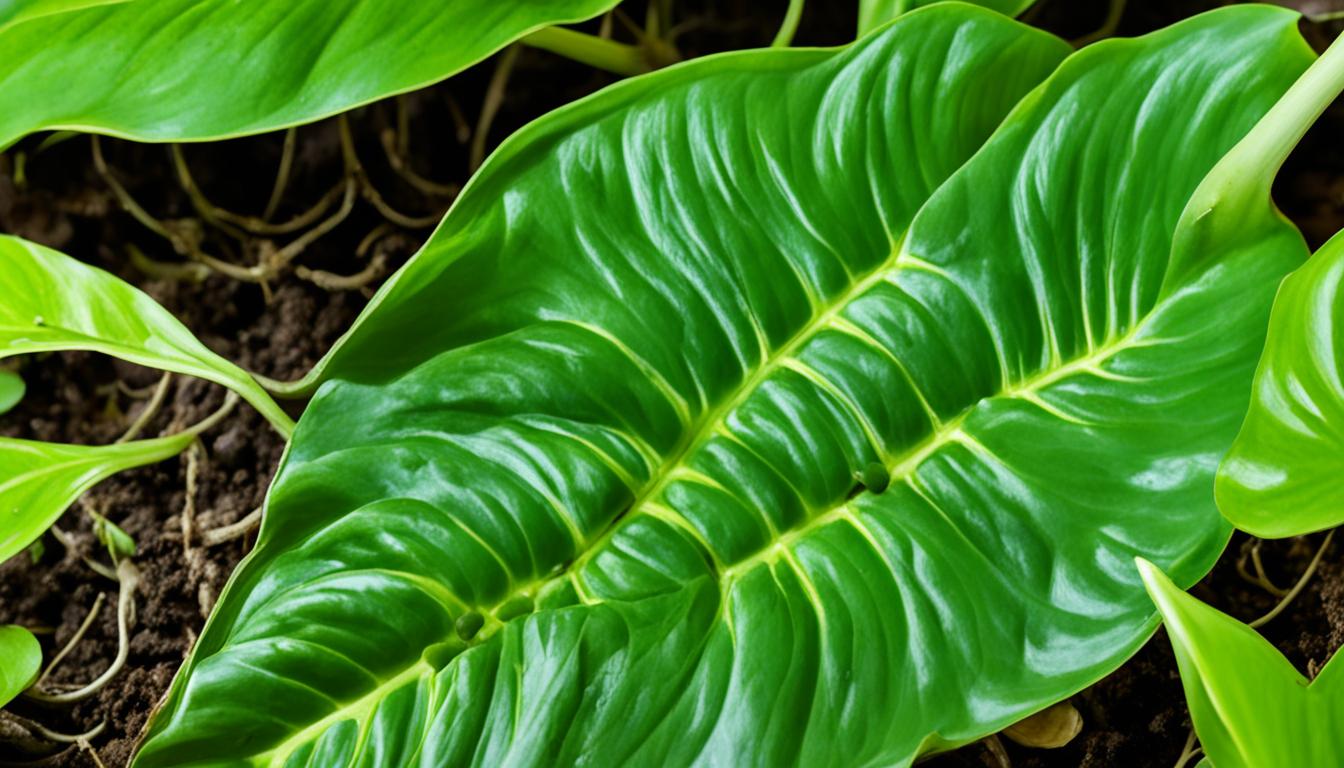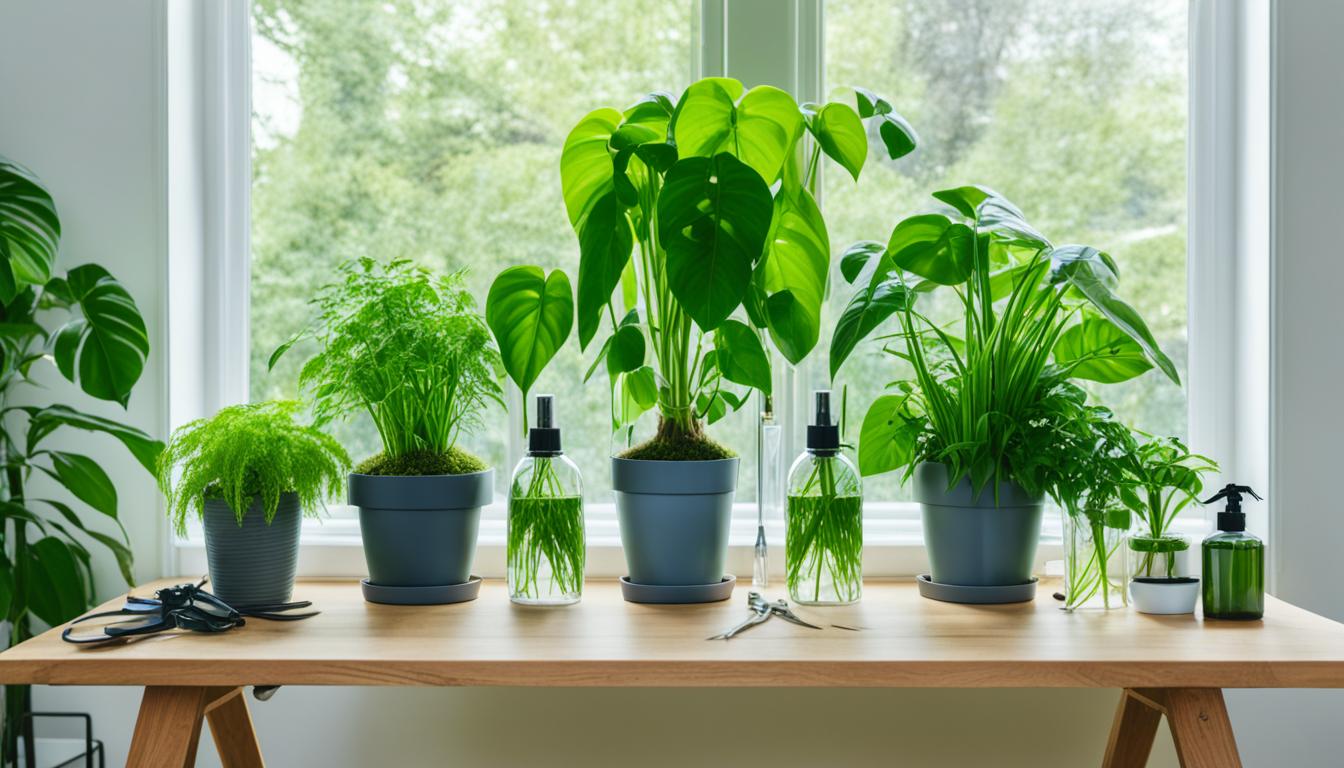Did you know that philodendrons are so popular in the United States? Over 50 million homes have one! These plants are great for beginners, bringing a tropical look indoors. You can make more plants easily by using cuttings or divisions. It’s a fun way to grow your plant family.
Philodendrons are easy to take care of, and people love them. They have heart-shaped leaves that shine. Their vines also make any space look great. You can make new plants by just taking a piece of the original and planting it. This guide will show you exactly how to do that.
Key Takeaways
-
Philodendrons are one of the most popular houseplants in the United States.
-
Philodendrons are easy to propagate from stem cuttings or divisions.
-
Propagating philodendrons allows you to multiply your plant collection.
-
Proper preparation and care are crucial for successful philodendron propagation.
-
Philodendrons are a fantastic choice for beginner plant enthusiasts.
Introduction to Philodendron Propagation
I love philodendrons because they are so adaptable and tough. They not only make any room look better with their green leaves, but they are also easy to make more of. You can get new philodendrons by using cuttings in water or soil. This is a great way for anyone new to plants to start making their collection bigger. You can soon have more of these beautiful plants to enjoy or share.
Understanding the Benefits of Plant Propagation
Making more plants by taking cuttings is a cool and cheap way to grow your plant family. Doing this with philodendrons means you don’t need to buy more. You see a small cutting grow into a big, healthy plant. This not only saves money but is also very satisfying and fun.
Why Philodendrons are Ideal for Beginners
Beginners will love philodendrons because they are easy to care for. These plants can handle different light and are very resilient. They do well in any light, from bright to low. With their unique leaves, they can brighten up any room. Growing more of them is a great way to start learning about plants. They are a perfect choice for first-timers in the plant world.
Choosing the Right Philodendron Cutting
The first step is picking a healthy stem from the mother plant. You need a strong piece to grow new leaves. The best ones are 3 to 6 inches long, with a node and some leaves.
Identifying Healthy Stems and Leaves
It’s key to choose plants that are free from diseases and bugs. Make sure it looks lively and strong. This way, your cutting will start off right in its new spot.
Selecting the Appropriate Stem Length
Pick a cutting that’s 3 to 6 inches with a node and leaves. It helps the cut do well in its new place.
Preparing the Philodendron Cutting
First, pick out a good cut. Then, prepare it for rooting. Make sure the tools are clean to prevent the plant from getting sick. A good cut under a node will help the cutting take in water and food better. This makes it easier for roots to grow.
Sanitizing Tools and Containers
To keep your philodendron cutting healthy, sanitize all your tools and containers. Use isopropyl alcohol to clean shears, scissors, or knives. Make sure to clean your containers well, too, with a mild disinfectant. This step is vital to avoiding the spread of diseases.
Removing Excess Foliage
Cut off the lower leaves to stop rot and make the roots grow better. You should keep some top leaves to help the plant get light. This helps it grow while it’s rooting. The right amount of leaves improves the philodendron’s success rate.
propagating a philodendron
There are many ways to make a new philodendron plant. Using a part of the plant and letting it grow in water or soil is common. Water propagation is easy. It lets you see the roots grow. You put the cutting in water until it grows roots, then plant it in soil.
Water Propagation Method
To grow a philodendron in water, cut off a healthy part. Put the end of it in a glass or jar filled with water. Keep the glass in a place with light but not direct sun. Change the water every few days. Soon, you will notice new roots at the base of the cutting.
Soil Propagation Method
Rooting in soil is how philodendrons usually grow. Stick the cutting into a pot with special soil that drains well. The soil should be damp, not wet, and the plant needs light and a little warmth. This way, it will grow roots and then become a new plant.
Using Rooting Hormones
A rooting hormone powder or gel can help the plant grow roots faster. Put a little bit on the end of the cutting before you plant it in water or soil. Follow the instructions on the product you choose. Rooting hormones make it more likely the plant will grow roots and become a new plant.
Caring for Propagated Philodendrons
It’s super important to take good care of your philodendrons when they’re new. No matter if you’re using water or soil to help them grow, the key is to keep the environment just right. This will help their roots grow strong and the new plants start well.
Monitoring Root Development
Water propagation means checking the water often. Make sure the cutting is always wet. Change the water every few days to avoid dirt and bugs. Watch for roots to start growing. When they’re a few inches long, you can move them into soil.
With soil propagation, it’s all about good moisture. Stick your finger in to see if the soil’s wet. It should be damp all the time, but not soaked. Don’t let it get too dry. That could stop the roots from growing right away.
Maintaining Optimal Growing Conditions
Philodendrons love warm, wet places like the tropics. Keep the room at 65–85°F (18–29°C). Try to make sure there’s at least 50% humidity in the air. They need bright light, but not sunlight that’s too strong.
Watching the roots and keeping the setting perfect can help your plants grow well. You can enjoy healthy philodendrons for a long time this way.
Transplanting and Establishing New Plants
When your philodendron cuttings’ roots are a few inches long, move them. Philodendrons need a special kind of soil. It should be loose, drain well, and have lots of organic stuff in it.
Preparing the New Potting Mix
Put a pot or container on a flat surface. Fill it with soil that drains well. Add peat moss, compost, or something else organic. This makes the soil just right for philodendrons. Water the soil before planting in it.
Proper Transplanting Techniques
Carefully take out the cutting with roots from its first pot. Be gentle to keep the roots safe. Put the plant in the middle of the new pot. Spread the roots out. Add more potting mix around the roots.
Hold back from compacting the mix. This lets water flow through. Leave a little space at the top for water. Press the mix gently to keep the plant steady.
Now, water the philodendron well. Make sure the water goes all through the soil. Put the plant where it can get bright light but not direct sun. Check the soil often. Water when it’s dry to make your plant happy in its new space.
Conclusion
Philodendrons are great for new plant lovers. They’re easy to grow and hard to kill. If you want to make more, you can do so from cuttings or by dividing the plant. Following the steps in this guide will help you do this.
Be patient and use the right methods, and you’ll love growing philodendrons. It’s great for anyone, whether you’re new to plants or have a big collection. Seeing a cutting grow into a new plant is very rewarding. So, start your philodendron-growing adventure now.
Philodendrons can live in many different spaces inside. Learning how to make more plants is fun. It lets you have more to enjoy and to give to others. Let your plant family grow, making your home look more like a tropical paradise.
<div class="quiz-container">
<h1> Propagating a Philodendron: A Beginner's Guide </h1>
<form id="philodendron-propagation-quiz">
<div class="question">
<h2>1. What is the best method for propagating a philodendron?</h2>
<label>
<input type="radio" name="q1" value="a"> Seed Propagation
</label>
<label>
<input type="radio" name="q1" value="b"> Stem Cuttings ✂️
</label>
<label>
<input type="radio" name="q1" value="c"> Root Division
</label>
<label>
<input type="radio" name="q1" value="d"> Air Layering
</label>
</div>
<div class="question">
<h2>2. How long should a stem cutting be for successful propagation?</h2>
<label>
<input type="radio" name="q2" value="a"> 1-2 inches
</label>
<label>
<input type="radio" name="q2" value="b"> 3-6 inches
</label>
<label>
<input type="radio" name="q2" value="c"> 7-10 inches
</label>
<label>
<input type="radio" name="q2" value="d"> Over 10 inches
</label>
</div>
<div class="question">
<h2>3. Which part of the cutting should be submerged in water for rooting?</h2>
<label>
<input type="radio" name="q3" value="a"> The leaves
</label>
<label>
<input type="radio" name="q3" value="b"> The node with aerial roots
</label>
<label>
<input type="radio" name="q3" value="c"> The woody part of the stem
</label>
<label>
<input type="radio" name="q3" value="d"> The tip of the stem
</label>
</div>
<div class="question">
<h2>4. How long does it typically take for roots to develop on a philodendron cutting?</h2>
<label>
<input type="radio" name="q4" value="a"> 1-2 days ⏰
</label>
<label>
<input type="radio" name="q4" value="b"> 1-2 weeks
</label>
<label>
<input type="radio" name="q4" value="c"> 3-4 weeks ️
</label>
<label>
<input type="radio" name="q4" value="d"> 2 months
</label>
</div>
<div class="question">
<h2>5. When should you transfer a rooted cutting to soil?</h2>
<label>
<input type="radio" name="q5" value="a"> As soon as roots appear
</label>
<label>
<input type="radio" name="q5" value="b"> When roots are 1-2 inches long
</label>
<label>
<input type="radio" name="q5" value="c"> When roots are 3-4 inches long
</label>
<label>
<input type="radio" name="q5" value="d"> Never, keep in water forever
</label>
</div>
<button type="button" onclick="checkAnswers()">Submit</button>
</form>
<div id="results"></div>
</div>
<style>
.quiz-container {
font-family: Arial, sans-serif;
max-width: 600px;
margin: auto;
padding: 20px;
border: 2px solid #4CAF50;
border-radius: 10px;
background-color: #f9f9f9;
}
h1 {
text-align: center;
color: #4CAF50;
}
.question {
margin-bottom: 20px;
}
label {
display: block;
margin: 5px 0;
}
button {
display: block;
width: 100%;
padding: 10px;
background-color: #4CAF50;
color: white;
border: none;
border-radius: 5px;
cursor: pointer;
}
button:hover {
background-color: #45a049;
}
#results {
margin-top: 20px;
text-align: center;
}
</style>
<script>
function checkAnswers() {
const answers = {
q1: 'b',
q2: 'b',
q3: 'b',
q4: 'b',
q5: 'b'
};
let score = 0;
const form = document.getElementById('philodendron-propagation-quiz');
const results = document.getElementById('results');
const formData = new FormData(form);
formData.forEach((value, key) => {
if (value === answers[key]) {
score++;
}
});
results.innerHTML = `<h2>Your Score: ${score}/5</h2>`;
if (score === 5) {
results.innerHTML += `<p> Excellent! You are a Philodendron propagation expert! </p>`;
} else if (score >= 3) {
results.innerHTML += `<p> Good job! Keep up the great work in propagating your plants! </p>`;
} else {
results.innerHTML += `<p> Keep learning and your Philodendrons will thrive! </p>`;
}
}
</script>
Propagating a Philodendron: A Beginner’s Guide
Related Articles:
By following this guide, you’ll be well on your way to becoming a philodendron propagation pro. Happy planting!
Source Links
propagating-a-philodendron


